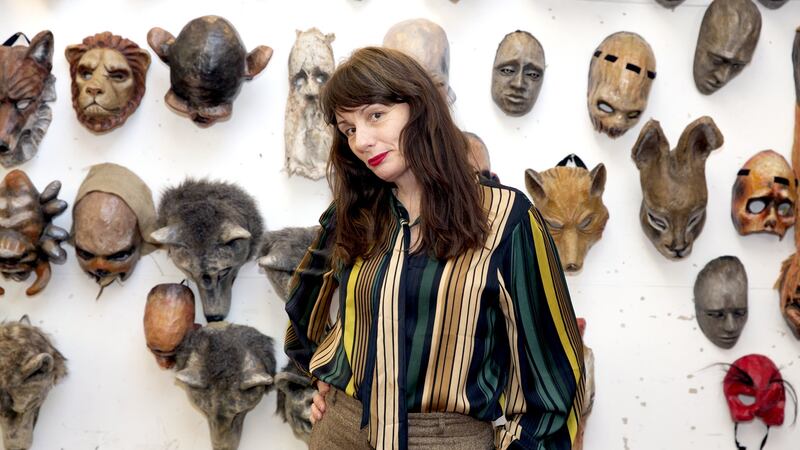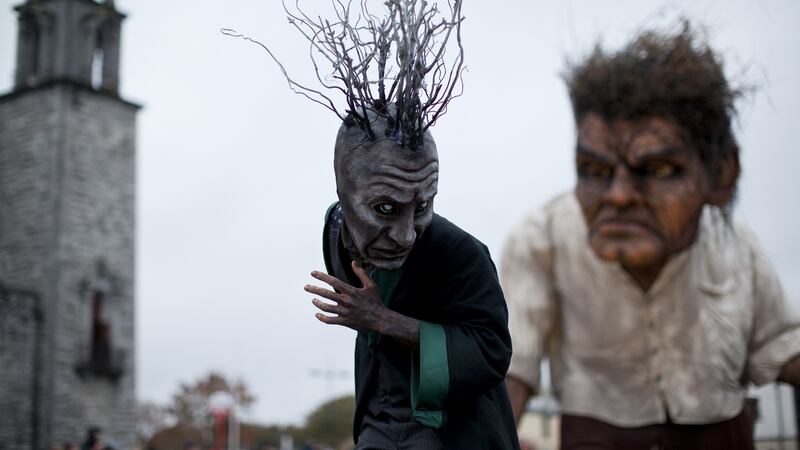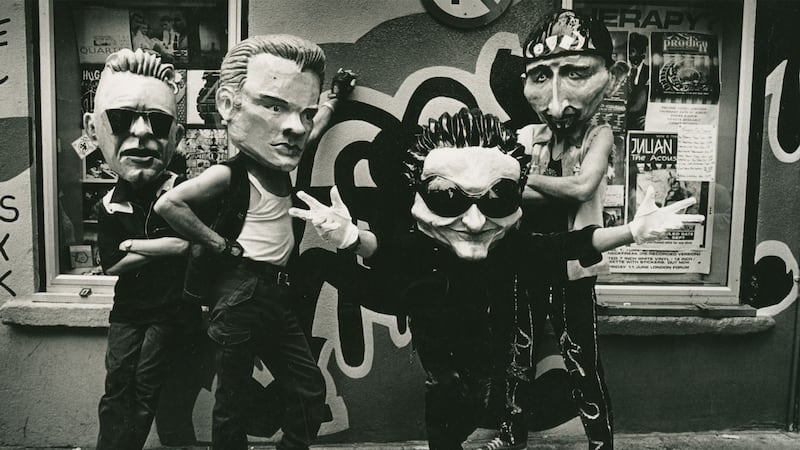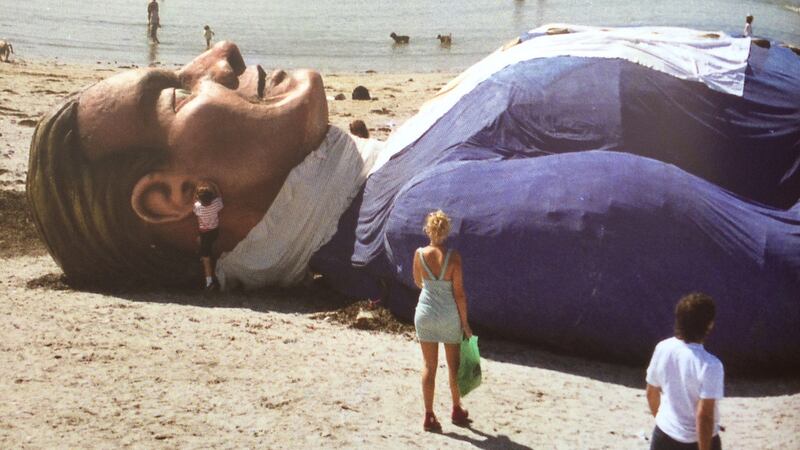It’s a giant, cavernous shed with a corrugated iron roof. Along the wall large, deep shelves are filled with enormous decapitated heads, various limbs crumpled in a heap below. In a corner a nine-foot tall creature is wrapped in plastic, beside giant mushrooms. A horse shape is discernible undercover. Bits of contraptions, tools and devices are everywhere. The cold permeates the concrete floor, and the soles of my shoes; our voices echo. Around the corner in another huge space, on a mixum-gatherum of sad-days sofas around a giant infrared heater, a few souls are gassing.
No, it’s not an apocalyptic scene from a house of torture or pestilence – though the outside world feels a bit like that these days. It’s the workshop and storage base of Macnas, the Galway-based creative ensemble that makes large-scale theatrical spectacles and innovative parades, and winner of the Special Tribute Award at the Irish Times Theatre Awards, recognising its contribution to Irish theatre culture and practice over three-plus decades. Macnas would have received the award on the podium on April 5th, had the ceremony gone ahead.

Eternity will be represented musically by a manic, maddening repetition of Happy Birthday
It’s the day before Leo Varadkar shut Ireland, but we don’t know that yet, and today Macnas starts the build for the first tranche of its most ambitious project, Gilgamesh, a flagship of Galway 2020 European Capital of Culture. Macnas is working with playwright Marina Carr, designer Julian Crouch, composer Nick Powell and cinematographer Colm Hogan on the legend of Gilgamesh – two-thirds god, one-third human hero-king of Mesopotamia, challenged by wild man Enkidu, in a story exploring human relationships, power, corruption, loneliness, friendship, loss, love, revenge, mortality and death.
Out in the factory of dreams, Emma O’Grady and Peter Casby are working on shadow puppetry. Orla Clogher, Gavin Morgan and Bill Wright are fiddling about with a cart, two glockenspiels and kinetic pieces, teasing out a device to harness to Outa, cursed with immortality; eternity will be represented musically by a manic, maddening repetition of Happy Birthday.
The former trucking depot is a 10-minute drive from Athenry, which is 25km from Galway city, but Macnas’s real home is its city base in Fisheries Field.
Crouched
The evening before the build began, Macnas invited guests to Fisheries Field near Salmon Weir Bridge to explain Gilgamesh. Macnas artistic director Noeline Kavanagh is crouched on her hunkers, like a beast ready to leap at a moment’s notice. She’s listening to other speakers, including Galway 2020’s programme head Marilyn Gaughan Reddan, about the Gilgamesh dream beginning five years ago. When Kavanagh herself speaks she’s like a creature possessed, bouncing around the room, expressive, booming, energising. A sort of inspiring force of nature, she prowls the crowd, describing the drama of the world’s first-ever hero’s journey.

There's a multitude of colours lurid and earthy, with panels, sequins, netting, different textures, feathers and fur
The compact rooms – a sort of shed at Fisheries Field – are part of a single-storey terrace backing onto Eglinton canal on the NUI Galway grounds. It’s where much magic has been made for 34 years. In the main room, the walls are lined with rows and rows of masks, headpieces, puppetry practice figures, atmosphere boards planning Gilgamesh, massive charts of Macnas’s weekly community ensemble workshops – in stilts, puppetry, brass, drums, performance. Led by 45 associate artists, these are part of its community arts remit, and their skills feed the large-scale performances.
There’s a small production office and a costume room with sewing machines, a cutting table, and rails and rails of costumes, including some really long trousers (for stilt-walkers). The constituents of tons of shows, there’s a multitude of colours lurid and earthy, with panels, sequins, netting, different textures, feathers and fur. Does anyone ever dress up and dance around of an evening? (Yes, is the answer.)
Gilgamesh for Galway 2020 is a year-long project, in four parts: unannounced live pop-up Fragments around the city and, digitally, originally planned for Easter Weekend, a street parade on midsummer’s night, Marina Carr’s script onstage in November and an epilogue in the wilds of Co Galway in December. Each part feeds thematically and stylistically into the others; it also creates work for 45 people, with the Macnas ensembles and the creative team, over a year.
While Gilgamesh is paused by the coronavirus, its elements in some ways represent strands of Macnas’s performances over three decades.
As Terry Dineen writes in a 2007 book for the company’s 21st anniversary, Macnas: Joyful Abandonment (Liffey Press), the journey of the Galway-based company has been “influenced by every person who has crossed the threshold of the workshop in Fisheries Field. Everyone associated with the company, past and present – artists, facilitators, managers, technicians, sponsors, volunteers, participants, audience and the general public – feels a sense of ownership of Macnas.”
Els Comediants
It was founded in 1986 by Páraic Breathnach, Tom Conroy, Ollie Jennings and Pete Sammon, who were inspired by Spanish theatre collective Els Comediants visiting Galway in 1985, Welfare State International’s street theatre handbook Engineers of the Imagination, and by travelling theatre company Footsbarn, who Jennings invited to perform in Galway in 1984.
With Conroy’s design and technical skills, Breathnach focusing on community involvement, Sammon on performance, and Jennings pulling it together, they magicked up an energy, visual imagination – and crack – in a style new to Ireland. The name came from “Macnas (noun). The frolic-like behaviour of a young calf let out to grass for the first time after being kept inside all winter; joyful abandonment; dalliance; wantonness.”

The country wasn't as colourful – but don't be mistaken; there was imagination and daftness and divilment
They were looking for “a new way to express frustration with society, a passion for spectacle and a healthy dose of luck and good timing”, as Dineen describes it, and became an artistic force in the 1980s’ depressed economy of unemployment allied with high education, and within the creative foment which also spawned the Galway Arts Festival, Druid Theatre and vibrant visual art, craft and musical traditions. For Galway’s generations following, that creativity in the air around us was a given, just as the annual Macnas parade on the middle weekend of the arts festival became a given.
As Leo Moran , later a Saw Doctor, and one of the first participants in Macnas’s SESs (social employment schemes) remarks: “It was 1987, the country wasn’t as colourful as it is nowadays, not as prosperous – but don’t be mistaken; there was imagination and ingenuity and daftness and divilment.”
A pageant and choreographed mock Gaelic game before the 1987 Galway-Mayo senior Connacht final made a splash locally. The following year a giant Gulliver (shoe size 210, weighing 2½ tons, and taking 40 people six months to build) washed up on Dollymount strand and floated on the Liffey to celebrate Dublin’s Millennium in 1988, and the wild west company slipped into the national consciousness.
The following years were twin track, with the annual arts festival parades growing in ambition and involving volunteer community performers, alongside touring plays, sometimes on outdoor stages, including a Celtic trilogy: Táin, Buile Shuibhne and Balor. They picked up on mythology, but also poked fun at politicians, priests, shopkeepers and gombeens.
Deserted warehouses
They toured unusual venues – disused garages, deserted warehouses and old cinemas – with shows such as Alice in Wonderland (1989), Treasure Island (1990) and Circus Story (1991).
Fir Bolgs, mythological Irish giants, lumbered through streets, and the characteristic Macnas “big heads” (made of papier-mâché and fibreglass) traipsed around Europe supporting U2 on its Zooropa tour in 1992. Macnas rang in 2000 simultaneously in Galway, Dublin and New York City, where it floated a giant baby over Times Square.
While Macnas evolved visually and technically, its style has always highly visual, physical and inventive.s

Around its 21st birthday, a 2007 Irish Times story by Michelle McDonagh asked if Macnas had lost its way
After its first decade Macnas was led by general managers including Declan Gibbons and John Ashton for some years, with various directors of individual shows in fluctuating styles, including Judith Higgins, Dominic Campbell, Mikel Murfi, Noeline Kavanagh (who after years abroad, later became artistic director) and Rod Goodall, who had rocked up with the circus that was Footsbarn, and stayed, becoming a key creative force for many years. As well as annual parades, myriad stage shows included Rhymes from the Ancient Mariner, The Dead School, The Mysteries, and The Odyssey with Els Comediants; they toured widely.
A commercial wing, Macteo, developed, doing commercial work alongside the community and creative arm, before splitting into a separate entity, Arcana, in 2007.
Family shake-up
It wasn’t the only split: there was a family shake-up in the late 1990s, and “Shakespearean aggro”, with stomping off and throat-slitting gestures, as Kavanagh, then part of a younger generation looking on, recalls it.
Around its 21st birthday, a 2007 Irish Times story by Michelle McDonagh asked if Macnas had lost its way, when one founder, Páraic Breathnach, accused the company of losing its raison d’être and criticised it for dropping the summer parade.
But it evolved through its growing pains, and fought and flourished over the decades, in turn inspiring other Irish street companies including Spraoi and Buí Bolg. Its name has gone into the lexicon, so lots of us understand what’s meant by “doing the Macnas”.
Noeline Kavanagh first directed a Macnas parade aged 23 in 1998. Returning as artistic director two decades later, she pioneered large-scale kinetic sculptures – pushing the boundaries of giant puppetry and interactivity – and more immersive spectacles, created community ensembles, toured internationally. Macnas’s now-annual nighttime Halloween parades (Danse Macabre last year) are the new fixture, testament to the ebb and flow of an organisation over decades.
Out in the workshop in Athenry, executive director Mark O’Donnell leads us round, and Kavanagh points out some milestones in the “shrine” to recent years: the wide-eyed four-metre tall Boy Explorer, a walking puppet that could be seen at a distance; the brown, wrinkled Crom, lurking beside him, was a step beyond – because he was brace-weighted, with a puppeteer in his head, he could bend and engage with the audience; Baba Yaga, now in pieces, pushed the technical giant puppetry further.
From big heads to engaging giants, Macnas’s large-scale storytelling and spectacle will somehow see out the coronavirus.
The performance schedule for Gilgamesh is under review. Updates will be on macnas.com and galway2020.ie













